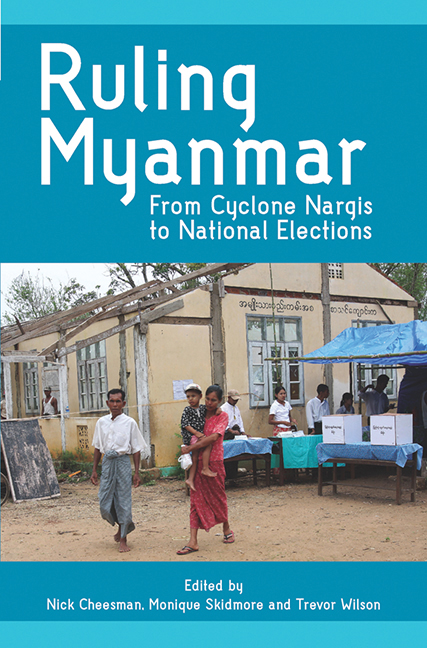Book contents
- Frontmatter
- Contents
- List of Tables
- List of Figures
- Background on ANU 2009 Myanmar/Burma Update Conference
- Acknowledgements
- Contributors and Editors
- Note on Terminology and Geographical Names
- Map of Myanmar
- Part I Overview
- Part II Political Legitimacy, Governance and Justice
- 2 2010 and the Unfinished Task of Nation-building
- 3 Burma's Political Transition: Implications for U.S. Policy
- 4 Sovereignty in the Shan State: A Case Study of the United Wa State Army
- 5 Governance and Legitimacy in Karen State
- 6 The Incongruous Return of Habeas Corpus to Myanmar
- Part III Economic Development, the Rural Economy and Labour Rights
- Part IV The Role of International Cooperation and Governance
- List of Abbreviations
- Index
6 - The Incongruous Return of Habeas Corpus to Myanmar
from Part II - Political Legitimacy, Governance and Justice
Published online by Cambridge University Press: 21 October 2015
- Frontmatter
- Contents
- List of Tables
- List of Figures
- Background on ANU 2009 Myanmar/Burma Update Conference
- Acknowledgements
- Contributors and Editors
- Note on Terminology and Geographical Names
- Map of Myanmar
- Part I Overview
- Part II Political Legitimacy, Governance and Justice
- 2 2010 and the Unfinished Task of Nation-building
- 3 Burma's Political Transition: Implications for U.S. Policy
- 4 Sovereignty in the Shan State: A Case Study of the United Wa State Army
- 5 Governance and Legitimacy in Karen State
- 6 The Incongruous Return of Habeas Corpus to Myanmar
- Part III Economic Development, the Rural Economy and Labour Rights
- Part IV The Role of International Cooperation and Governance
- List of Abbreviations
- Index
Summary
INTRODUCTION
A cartoon published in the state-run periodical Shwenaingan during May 2009 neatly captured the contradictory features of the 2008 Constitution of Myanmar. While the charter purports to guarantee its citizens equality, in cartoon form it stands with arms and legs outstretched, guarding the entrance to a new peaceful, modern, developed and discipline-flourishing democratic nation. Outside the entrance is the reason for its posture: darkly clad troublemakers are trying to get in. But the constitution has foiled them. It is not treating them as equals at all. They belong to some category of persons for whom the rights it proclaims do not belong even in principle, let alone in practice.
The new charter is not so much a supreme law as it is a supreme statement of how law in Myanmar has been subordinated to ruling group interests, evoking certain ideas of the Nazi jurist Carl Schmitt. Its obsessive concern with dangers to national sovereignty of the type visualized in the cartoon speak to his dictum that, “The specific political distinction to which political motives and actions can be reduced is that between friend and enemy” (Schmitt 2007, p. 26). Its section 20(f) situates the armed forces in the place of his executive president as guardian of the constitution. How they are to play that role is not explained, but by Schmitt's criterion — that the sovereign is he who decides the exception (Schmitt 1985, p. 5) — Myanmar's top military officer, not its president, remains the ultimate authority. And a full chapter of the constitution is devoted to undefined states of emergency during which the commander has unrestrained authority, again as Schmitt would have it. Its subtext is that anyhow he has the prerogative to ignore its terms where expedient.
At the same time, the charter restores features of the 1947 Constitution that were written out of its 1974 counterpart. Among these, the constitution has reassigned the Supreme Court authority to hear writ petitions, including for habeas corpus. This writ holds a special place not only in the emergence of civil rights globally but also in the earlier constitutional history of Myanmar or, as it was known then, Burma.
- Type
- Chapter
- Information
- Ruling MyanmarFrom Cyclone Nargis to National Elections, pp. 90 - 112Publisher: ISEAS–Yusof Ishak InstitutePrint publication year: 2010



